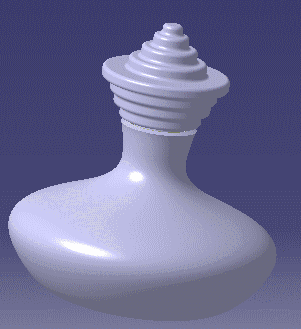

Configuration 1
of KwrProfilesDesignTable.xls
applied to
KwrBottleProfiles.CATPart
The bottle above is used to demonstrate the major knowledgeware techniques
that can be used in CATIA Version 5 to help you design a product. Throughout
this section, most facets of the CATIA knowledgeware capabilities are examined,
from relations such as formulas and rules to optimization
algorithms.
A scenario is developed in every chapter around a specific theme, and for each
scenario tips and techniques are given.
This part is intended for advanced users. Before you tackle the scenarios defined in this guide it is better to have previous knowledge of the products listed below and have an idea of the basic tasks you can carry out with them:
|
|
|
|
|
When developing a product, you must first of all define your product requirements. These requirements may be the result of mechanical, manufacturing or style considerations. The approach you follow in knowledge-based design consists in integrating these requirements in specific tools so that, for example you can check and validate data during the design process or observe how your document behaves depending on the context. This chapter defines the requirements of the bottle used as an example and explains how to capture your design intent, i.e. describe your requirements through knowledgeware features.
Suppose you are designing a new bottle and you are required to make proposals to your marketing department. Leaving aside style considerations, you are free to do what you want except for the following restrictions:
|
|
The trick for you now is to determine the volume of the bottle, have this volume updated whenever you change the bottle's shape and be warned should the calculated volume be out of range.
The approach followed to capture this design intent relies on measures. The "measure" capabilities provide you with a function which calculates the volume of a body. There is no real means to prevent you from designing bottles that are too small or too large, but using Knowledge Advisor checks is a good way to be warned whenever the volume is out of range. This is explained in Calculating and Checking a Volume.
Having on hand a series of bottles' shapes fulfilling all requirements, you are required to be able to refine your result and search for a design so that the exact volume of the bottle is 250 cm3. To achieve this goal, we use the Product Engineering Optimizer capabilities and both available algorithms to design the final bottle shape. This is explained in Optimizing a Volume.
It is planned to provide the bottle with a cap. After reviewing development plans with the marketing department, it has been decided that selling this new perfume brand with an already existing cap would be a saving. The cap they plan to reuse is the one below:
 |
Reusing this cap affects the bottle neck design which must
allow for a certain section as well as a certain depth. Although it is planned to re-design this cap, the marketing department would like to have an idea of the assembly made up of the bottle and the cap. To check the overall design of the product, the marketing people want to be able to generate the bottle assembly automatically on screen each time a bottle shape meets the requirements. |
A CATIA Knowledgeware answer to this problem is a Knowledge Advisor rule which can be triggered whenever certain conditions are fulfilled and generate automatically the global assembly from a VB macro. This is explained in detail in About Rule Firing. How you record, replay or modify a macro is discussed in CATIA Knowledgeware Automation.
The Marketing Department already has an idea about the shapes they would like to study. The proposed shapes should be revolution bodies. The longitudinal view of the product should exhibit no edges. In other words, all contours are intended to be smooth. Stylists want you to provide them with a flexible design, they want profiles that are easy to be deformed by controlling one or more parameters. They want an immediate result on screen and they also want a clue as to whether they are still working within the authorized limits.
Our initial feature is a five-point spline. The points making up the bottle neck are fixed as they must accommodate the cap. The other points are those providing the required flexibility. You alter them to create a new bottle shape. To create a bottle, you must create the spline, then rotate this spline. At this stage you obtain a revolution surface open at both ends. Then you have to create a fill at the aperture which is assumed to be the bottom of the bottle, join all the faces and thicken the resulting joined surface. All this is described in Appendix: Creating a Deformable Revolution Body.
After a new shape has been designed and satisfies the requirements, you can store its parameters in a design table. The design table is a way to gather in an external file all the profiles satisfying the requirements. How to create a design table storing the data of all profiles and how to use a design table are explained in Working with a Design Table.